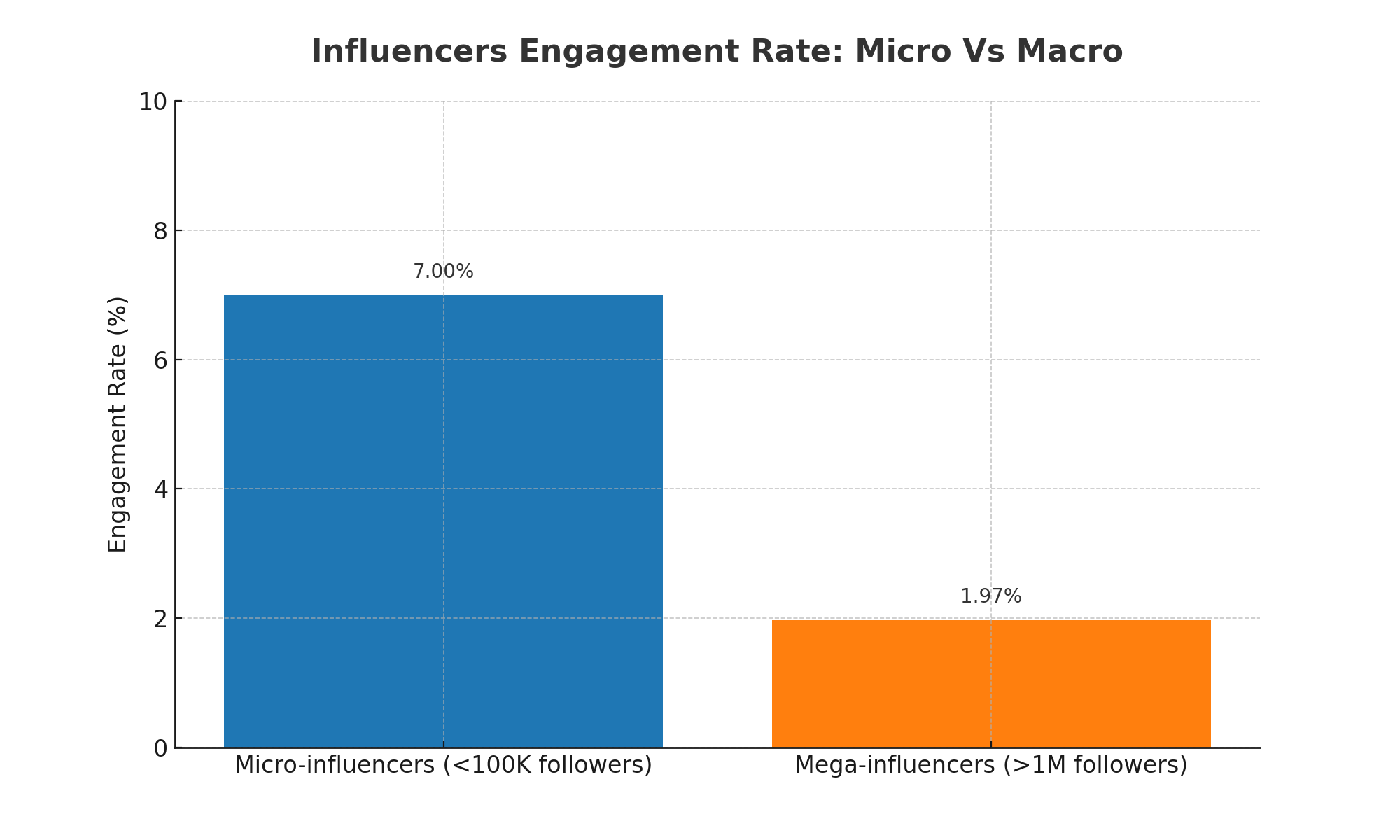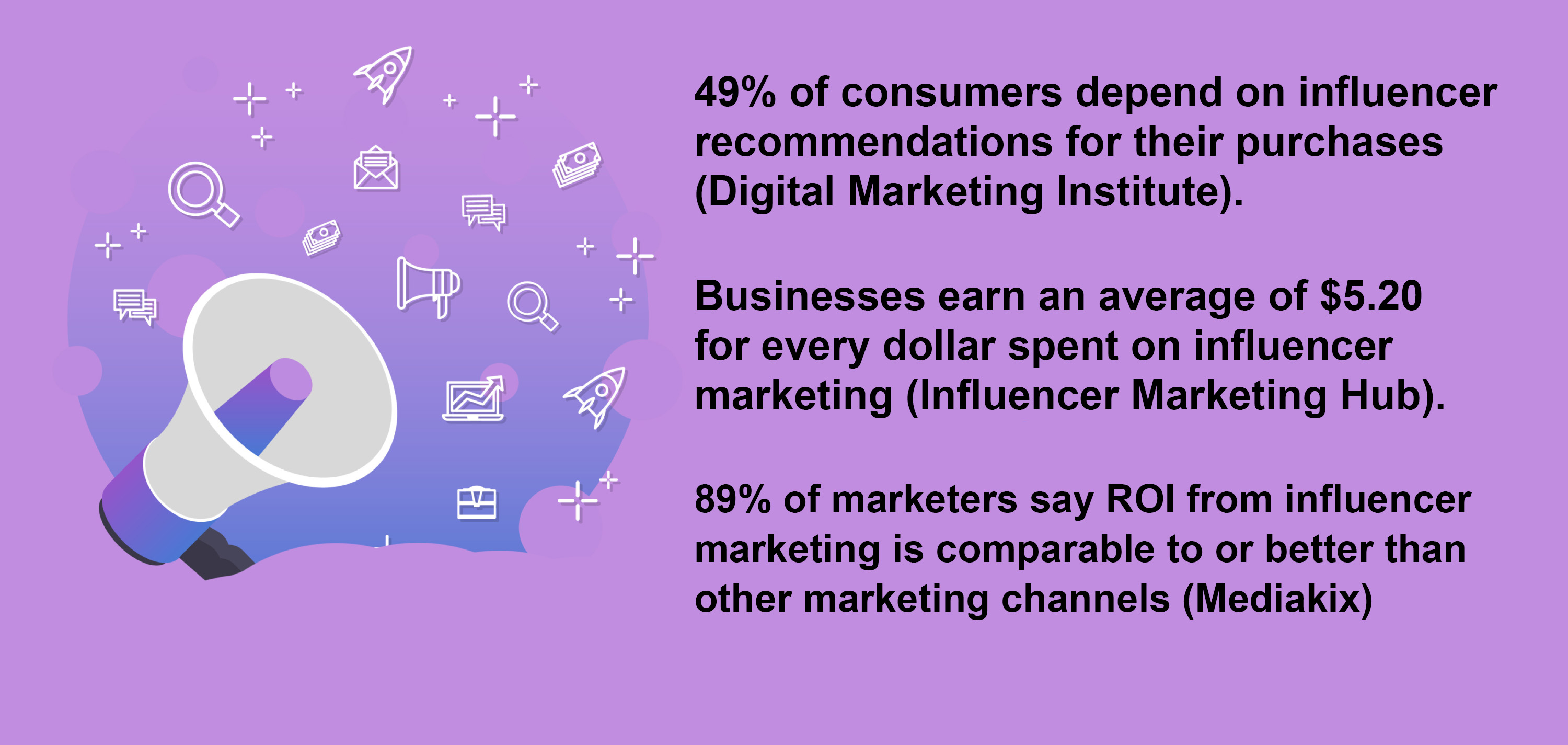
Micro-Influencers vs. Mega-Stars: Who's Right for Your Brand
Ever scrolled through Instagram and stumbled upon a celebrity promoting the latest fitness tracker? Or maybe you've seen a local baker with a passionate following showcasing their mouthwatering cupcakes? That's the magic of influencer marketing – leveraging social media personalities to connect with potential customers. But with a vast influencer landscape, choosing the right partner can feel overwhelming. Here's where understanding the two main categories, micro and mega-influencers, comes in.
The Micro-Influencer Advantage: Authenticity & Trust
Imagine your ideal customer – someone who shares your brand's values and gets genuinely excited about what you offer. Micro-influencers, typically boasting follower counts between 10,000 and 100,000, often embody this ideal. They cultivate close-knit communities where their recommendations hold significant weight.
Here's the secret sauce: micro-influencers tend to have higher engagement rates compared to their mega-counterparts. Studies by Influencer Marketing Hub show that engagement rates (likes, comments, shares) plummet as follower counts climb. Why? Micro-influencers foster a more personal connection with their audience, leading to more meaningful interactions and a sense of trust.
Think of it like this: Imagine attending a massive party with hundreds of people. It's tough to have a deep conversation, right? Now, picture a cozy gathering with close friends. Sharing, laughter, and genuine connection flow naturally. That's the micro-influencer dynamic – a smaller, highly engaged audience where your brand message resonates deeply.

Targeting the Right Niche: Micro-influencers often specialize in specific niches. A food blogger might focus on vegan recipes, while a gamer might review indie titles. This laser-focused approach allows them to build a loyal following with genuine interest in their content area. For your brand, this translates to reaching a highly targeted audience who's already pre-disposed to products or services like yours.
Example in Action: Let's say you're a sustainable clothing brand. Partnering with a micro-influencer known for eco-conscious fashion choices is a perfect fit. Their audience trusts their recommendations, making them more receptive to your brand message.
Budget-Friendly Boost: Here's another perk – collaborating with micro-influencers can be significantly more cost-effective than mega-stars. This allows you to stretch your marketing budget further, potentially running multiple campaigns and reaching diverse segments of your target audience.
The Flip Side of the Coin: While micro-influencers offer incredible engagement and niche targeting, their reach might be limited compared to mega-stars. This can be a drawback if brand awareness is your primary goal.
Mega-Influencers: The Power of Celebrity Reach
Think A-list celebrities or social media giants boasting millions of followers. That's the realm of mega-influencers. These personalities have the power to catapult your brand into the spotlight, generating significant buzz and brand awareness. Imagine your product being featured on a popular talk show host's Instagram – instant recognition and a potential surge in interest.
The Numbers Speak for Themselves: A study by Influencer Marketing Hub revealed that campaigns featuring mega-influencers typically generate higher viewership and impressions (the number of times your content is seen). This translates to significant brand exposure, potentially reaching millions of potential customers.
Think Big, Think Broad: Mega-influencers often have a broader, less-defined audience. While engagement rates might be lower, the sheer number of followers they reach can be astronomical. This can be ideal for brands looking to create a splash and gain widespread recognition.
Example in Action: A new line of sports apparel could benefit greatly from a partnership with a famous athlete. Their massive fan base gets exposed to the brand, potentially sparking interest and driving sales.
The Cost Factor: Here's the catch – securing a mega-influencer partnership typically comes with a hefty price tag. This can be a barrier for smaller businesses or those just starting with influencer marketing.
Beyond the Numbers: It's also crucial to consider whether a mega-influencer's brand alignment is a good fit. A mismatch can lead to inauthentic endorsements that fall flat with your target audience.

So, Who's the Perfect Match?
The ideal influencer partner depends on your specific marketing goals and budget. Here's a quick breakdown to help you decide:
Choose Micro-Influencers if:
- Authenticity and engagement are top priorities.
- You have a well-defined target audience.
- You're working with a limited budget.
Choose Mega-Influencers if:
- Brand awareness is your primary goal.
- You want to reach a massive audience.
Beyond the Micro vs. Mega Dichotomy
While micro and mega-influencers represent the two ends of the spectrum, it's important to remember the influencer landscape is vast and nuanced. There are "mid-tier" influencers with follower counts in the hundreds of thousands, offering a balance between reach and engagement. Additionally, nano-influencers, with follower counts below 10,000, can be hyper-local and highly engaged within a specific community.
The key is to understand your target audience and brand goals to determine the ideal influencer tier. Researching platforms like socialbakers.com or influencer marketing marketplaces can help you discover relevant influencers with the right audience demographics and engagement metrics.
Did you know that 60% of Instagram users say they discover new products on the platform? Pretty impressive, right?
It’s no wonder 89% of marketers using influencer marketing plan to increase or maintain their budgets. Influencer marketing is clearly paying off!
In fact, 17% of companies are now spending over half of their marketing budget on influencers.
Trust plays a huge role too—91% of millennials trust online reviews as much as recommendations from friends and family.
Instagram is a favorite for marketers, with 67% using it for influencer marketing.
And it’s working! 54% of female consumers have purchased a product after seeing it recommended by an influencer.
Plus, 80% of social media marketers say that influencer content performs just as well or even better than brand-created content.
Building a Winning Influencer Marketing Strategy
Simply choosing the right influencer isn't enough. To maximize the impact of your campaign, consider these additional factors:
Campaign Objectives & Content Strategy:
- Define your goals: Is it brand awareness, website traffic, or driving sales?
- Craft compelling content: Align the influencer's content style with your brand's message and target audience.
- Be transparent: Clearly disclose sponsored content to maintain audience trust.
Tracking & Measurement:
- Set clear KPIs (Key Performance Indicators): Align with your goals (e.g., website clicks, social media engagement).
- Utilize analytics tools: Track campaign performance and adjust strategies as needed.
Building Long-Term Relationships:
- Focus on collaboration: Work with the influencer to create authentic content that resonates with their audience.
- Nurture the relationship: Invest in building a long-term partnership for sustained brand advocacy.

The Power of Micro-Influencer Communities:
A rising trend is the emergence of influencer communities – curated groups of micro-influencers specializing in a specific niche. Partnering with such communities allows you to tap into a network of like-minded creators, reaching a highly targeted audience at scale while maintaining the benefits of micro-influencer engagement.
Extra Resources:
- Instagram Hacks for Small Businesses & Restaurants
- Micro-Influencers: Small Followers, Big Impact - Decoding the Trend
- Marketing on a Dime: Stretch Your Budget Like a Gymnast
- What is Faceless Marketing
- How does influencer marketing impact website traffic?
The Takeaway: Choosing Your Influencer Partner
Ultimately, the "right" influencer isn't just about follower count but about alignment. Consider these questions:
- Does the influencer's audience match your target market?
- Does their content style resonate with your brand image?
- Do they demonstrate a genuine passion for the product or service?
By answering these questions and implementing the strategies outlined above, you'll be well on your way to finding the perfect influencer partner to amplify your brand message and achieve your marketing goals. Remember, influencer marketing is a journey, not a destination. Experiment, refine your approach, and build genuine connections – the rewards can be a thriving online presence and a loyal customer base.
**Why Choose Unlimited Exposure Online for Social Media Marketing in Toronto?**
Unlimited Exposure Online – Experts in Influencer Marketing for Toronto Restaurants.
For nearly 30 years, Unlimited Exposure Online has been a pioneer in crafting stunning and affordable website designs in Toronto, having launched over 1,400 sites! Today, our innovative digital marketing strategies help businesses elevate their online presence.
Frustrated with finding the perfect "Toronto digital marketing agency"? Let’s talk! We make it a priority to understand your goals, develop personalized video marketing strategies, and deliver measurable results. Our services are flexible and tailored to meet your specific needs. Reach out to us today and discover the difference we can make!
